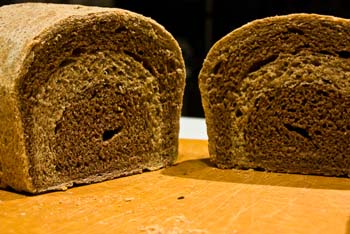I’ve been reading The Bread Baker’s Apprentice: Mastering the Art of Extraordinary Bread

The preparation was actually fairly straightforward, and this bread can actually be made in just one day. One batch of rye dough is made just as you’d expect. The second batch has coloring mixed in so that it’s darker than the first. The instructions tell you to use white rye, which would have been wise, but since I already had rye flour (not white), I didn’t see the point in purchasing more. In the book, the color difference is striking. In my loaf, it’s a bit more subdued. The coloring is given to the darker portions of the bread by either liquid caramel coloring or cocoa, carob, or coffee powder dissolved in water. For my loaf, I went with what I had, which happened to be cocoa powder. I didn’t feel like hunting up liquid caramel coloring, though I will admit that my cocoa powder added just the slightest bitter tinge to the darker colored rye – a result that Mr. Reinhart dutifully warned about.
As always Mr. Reinhart’s instructions are very clear, and the loaf shaping is accompanied by copious photos to illustrate the steps. After the doughs were allowed to sit and ferment, I split each in half. Then I rolled out the halves into roughly 8" x 5" squares (sort of) and stacked them up, alternating between the light rye and the dark rye. Once they were stacked, I pressed gently to combine, then essentially attempted to roll the four layers up into a batard shaped loaf. I laid that into a loaf pan and baked till it was done.
As rye breads go, this one wasn’t too bad. It wasn’t my favorite, but it was serviceable. As you can see from the photo above, I went for more of a spiral shape (sort of) instead of proper marbling, and it would have been prettier with more of a contrast between the two bread colors. But it was reasonably striking as it was.
The picture I’m showing you above is of a relatively nice looking loaf, however, my whole loaf didn’t look like this. In portions of it, the layers became separated, and long skinny air gaps developed. I read and reread the instructions and couldn’t find a missed step that might have created that. My guess is that the dough I made was a bit drier than it should have been and consequently the layers did not adhere to each other the way I might have liked. My single biggest challenge when baking bread is finding the right balance between adding enough flour to keep the dough from sticking to the counter and not working in so much flour that the dough is dry. Also, while it shouldn’t have an impact, I will say that I cut the recipe in half, so I came away with a single loaf instead of two. As I’m working through these bread experiments, I’m finding it difficult to consume all that I cook. I’ve tried freezing the breads, but have had mixed results.
I know I’ve said this before, but I’ll say it again. The Bread Baker’s Apprentice is a fine book with well laid out instructions and excellent background information. I believe the less-than-perfect nature of this loaf represents my experience as a bread baker more than it represents the quality of this text.